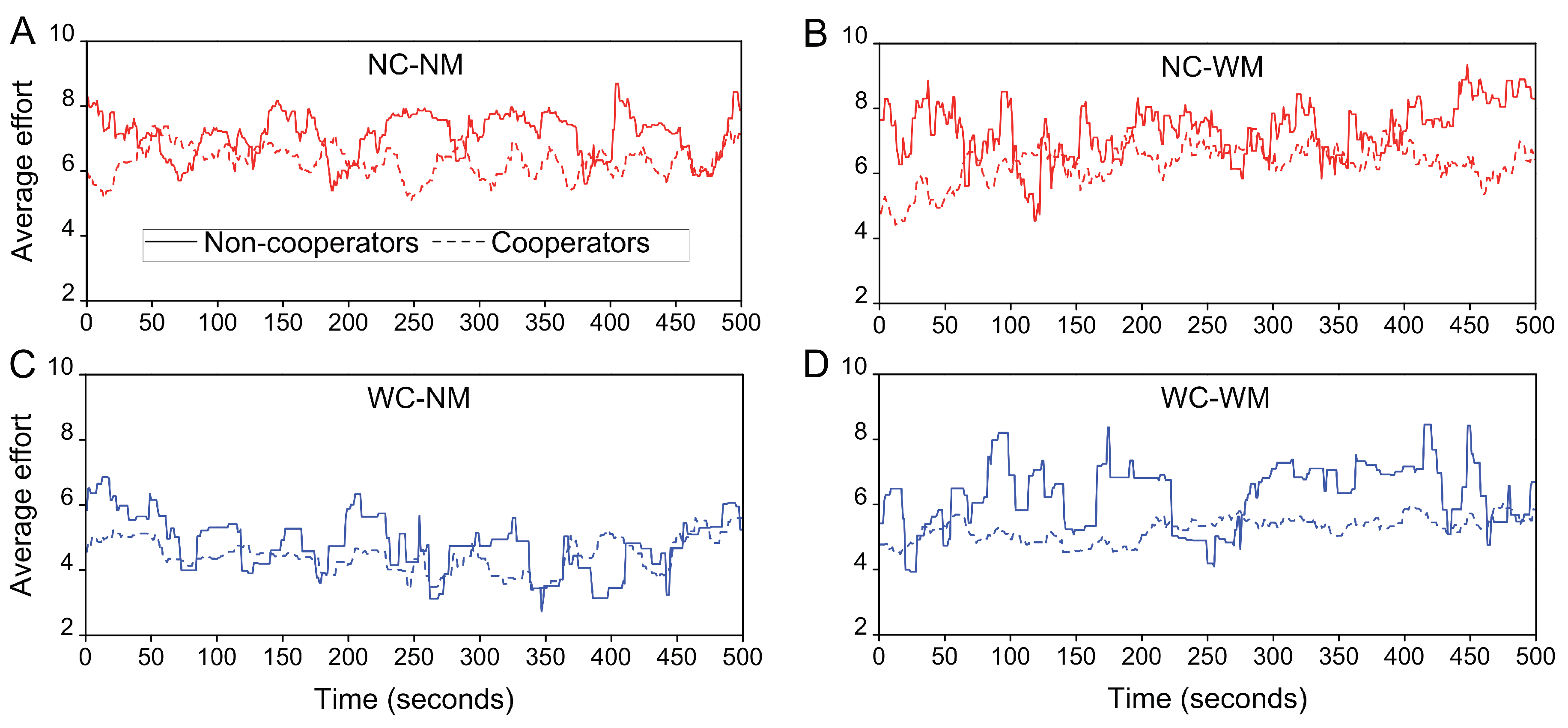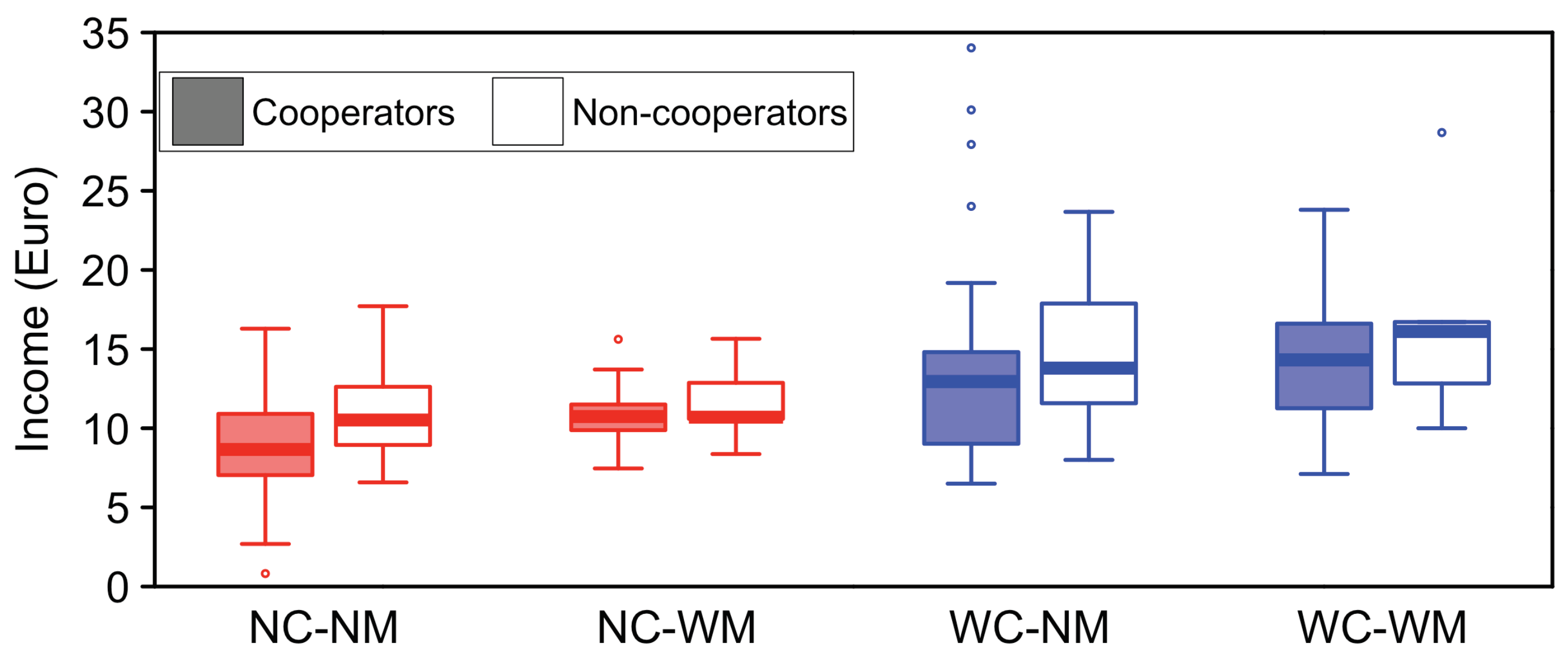Extraction Behaviour and Income Inequalities Resulting from a Common Pool Resource Exploitation
Abstract
:1. Introduction
2. Materials and Methods
2.1. CPR Experiment
2.2. Incentivized Task for Inferring the Cooperative Traits of Participants
2.3. Data Analysis
3. Results and Discussion
3.1. Main Results
3.2. Effort Dynamics for Cooperators and Non-Cooperators
3.3. Harvest Distribution
4. Conclusions
Supplementary Materials
Author Contributions
Funding
Acknowledgments
Conflicts of Interest
References
- Ranjan, R. Linking common property resource management to human capital outcomes. Ecol. Econ. 2014, 105, 139–153. [Google Scholar] [CrossRef]
- Gelcich, S.; Guzman, R.; Rodríguez-Sickert, C.; Castilla, J.C.; Cárdenas, J.C. Exploring external validity of common pool resource experiments: insights from artisanal benthic fisheries in Chile. Ecol. Soc. 2013, 18, 2. [Google Scholar] [CrossRef]
- Bluffstone, R.; Dannenberg, A.; Martinsson, P.; Jha, P.; Bista, R. Cooperative Behavior and Common Pool Resources: Experimental Evidence From Community Forest User Groups in Nepal (English); Policy Research Working Paper WPS 7323; World Bank Group: Washington, DC, USA, 2015. [Google Scholar]
- Pham, L.; Otto, I.; Zikos, D. Self-Governance and the Effects of Rules in Irrigation Systems: Evidence from Laboratory and Framed Field Experiments in China, India and Vietnam. Water Econ. Policy 2018. [Google Scholar] [CrossRef]
- Roßner, R.; Zikos, D. The role of homogeneity and heterogeneity among resource users on Water Governance: Lessons learnt from an economic field experiment on irrigation in Uzbekista. Water Econ. Policy 2018, 4, 1850008. [Google Scholar] [CrossRef]
- Sarker, A.; Baldwin, C.; Ross, H. Managing groundwater as a common-pool resource: An Australian case study. Water Policy 2009, 11, 598–614. [Google Scholar] [CrossRef]
- Kramer, R.; Brewer, M. Choice behavior in social dilemmas: Effects of social identity, group size, and decision framing. J. Personal. Soc. Psychol. 1986, 50, 543–549. [Google Scholar]
- Ostrom, E.; Gardner, R.; Walker, J. Rules, Games, and Common-Pool Resources; University of Michigan Press: Ann Arbor, MI, USA, 1994. [Google Scholar]
- McClintock, C.G. Social motivation—A set of propositions. Syst. Res. Behav. Sci. 1972, 17, 438–454. [Google Scholar] [CrossRef]
- Liebrand, W.B.; Jansen, R.W.; Rijken, V.M.; Suhre, C.J. Might over morality: Social values and the perception of other players in experimental games. J. Exp. Soc. Psychol. 1986, 22, 203–215. [Google Scholar] [CrossRef]
- Sheldon, K.M.; McGregor, H.A. Extrinsic value orientation and “the tragedy of the commons”. J. Personal. 2000, 68, 383–411. [Google Scholar] [CrossRef]
- Kimbrough, E.O.; Vostroknutov, A. The social and ecological determinants of common pool resource sustainability. J. Environ. Econ. Manag. 2015, 72, 38–53. [Google Scholar] [CrossRef] [Green Version]
- Janssen, M.A.; Holahan, R.; Lee, A.; Ostrom, E. Lab experiments for the study of social-ecological systems. Science 2010, 328, 613–617. [Google Scholar] [CrossRef] [PubMed]
- Ostrom, E.; Walker, J. Communication in a Commons: Cooperation without External Enforcement. In Contemporary Laboratory Research in Political Economy; Palfrey, T., Ed.; University of Michigan Press: Ann Arbor, MI, USA, 1991; pp. 287–322. [Google Scholar]
- Ostrom, E. The value-added of laboratory experiments for the study of institutions and common-pool resources. J. Econ. Behavior Organ. 2006, 61, 149–163. [Google Scholar] [CrossRef]
- Balliet, D. Communication and cooperation in social dilemmas: A meta-analytic review. J. Confl. Resolut. 2010, 54, 39–57. [Google Scholar] [CrossRef]
- Otto, I.; Wechsung, F. The effects of rules and communication in a behavioral irrigation experiment with power asymmetries carried out in North China. Ecol. Econ. 2014, 99, 10–20. [Google Scholar] [CrossRef]
- Ostrom, E.; Walker, J.; Gardner, R. Covenants with and without a Sword: Self-governance Is Possible. Am. Political Sci. Rev. 1992, 86, 404–417. [Google Scholar] [CrossRef]
- Fehr, E.; Gächter, S. Cooperation and punishment in public goods experiments. Am. Econ. Rev. 2000, 690, 980–994. [Google Scholar] [CrossRef]
- Gibson, C.C.; Williams, J.T.; Ostrom, E. Local enforcement and better forests. World Dev. 2005, 33, 273–284. [Google Scholar] [CrossRef]
- De Melo, G.; Piaggio, M. The perils of peer punishment: Evidence from a common pool resource framed field experiment. Ecol. Econ. 2015, 120, 376–393. [Google Scholar] [CrossRef]
- Cardenas, J.C. Real wealth and experimental cooperation: Experiments in the field lab. J. Dev. Econ. 2003, 70, 263–289. [Google Scholar] [CrossRef]
- Baumgärtner, S.; Drupp, M.; Meya, J.; Munz, J.; Quaas, M. Income inequality and willingness to pay for environmental public goods. J. Environ. Econ. Manag. 2017, 85, 35–61. [Google Scholar] [CrossRef] [Green Version]
- Islam, S.N. Inequality and Environmental Sustainability; DESA Working Paper No. 145, ST/ESA/2015/ DWP/145; Department of Economic and Social Affairs, UN Secretariat: New York, NY, USA, 2015. [Google Scholar]
- Mikkelson, G.M.; Gonzalez, A.; Peterson, G.D. Economic inequality predicts biodiversity loss. PLoS ONE 2007, 2, e444. [Google Scholar] [CrossRef] [PubMed]
- Cardenas, J.C.; Stranlund, J.; Willis, C. Economic inequality and burden-sharing in the provision of local environmental quality. Ecol. Econ. 2002, 40, 379–395. [Google Scholar] [CrossRef] [Green Version]
- Butler, C. Inequality and Sustainability. Ph.D. Thesis, The Australian National University, Canberra, Australia, 2002. [Google Scholar]
- Dorling, D. Social inequality and environmental justice. Environ. Sci. 2010, 19, 9–13. [Google Scholar]
- Baland, J.M.; Platteau, J.P. The ambiguous impact of inequality on local resource management. World Dev. 1999, 27, 773–788. [Google Scholar] [CrossRef]
- Olson, M. The Logic of Collective Action; Harvard University Press: Cambridge, MA, USA, 1965. [Google Scholar]
- Dayton-Johnson, J.; Bardhan, P. Inequality and conservation on the local commons: A theoretical exercise. Econ. J. 2002, 112, 577–602. [Google Scholar] [CrossRef]
- Brandt, G.; Kulesz, M.M.; Nissen, D.; Merico, A. OGUMI: A new mobile application to conduct common-pool resource experiments in continuous time. PLoS ONE 2017, 12, e0178951. [Google Scholar] [CrossRef] [PubMed]
- Bigoni, M.; Casari, M.; Skrzypacz, A.; Spagnolo, G. Time horizon and cooperation in continuous time. Econometrica 2015, 83, 587–616. [Google Scholar] [CrossRef]
- Harrison, G.; List, J. Field Experiments. J. Econ. Lit. 2004, 42, 1009–1055. [Google Scholar] [CrossRef]
- Pelligra, V.; Stanca, L. To give or not to give? Equity, efficiency and altruistic behavior in an artefactual field experiment. J. Socio-Econ. 2013, 46, 1–9. [Google Scholar] [CrossRef]
- Janssen, M.; Anderies, J.; Cardenas, J.C. Head-enders as stationary bandits in asymmetric commons: Comparing irrigation experiments in the laboratory and the field. Ecol. Econ. 2011, 70, 1590–1598. [Google Scholar] [CrossRef]
- Exadaktylos, F.; Espín, A.; Braãs Garza, P. Experimental subjects are not different. Sci. Rep. 2013, 3, 1213. [Google Scholar] [CrossRef] [PubMed]
- Clark, C.W. Mathematical Bioeconomics: The Mathematics of Conservation, 3rd ed.; John Wiley & Sons: Hoboken, NJ, USA, 2010. [Google Scholar]
- Schaefer, M.B. Some aspects of the dynamics of populations important to the management of the commercial marine fisheries. Bull. Math. Biol. 1991, 53, 253–279. [Google Scholar] [CrossRef]
- Balafoutas, L.; Kerschbamer, R.; Sutter, M. Distributional preferences and competitive behavior. J. Econ. Behav. Organ. 2012, 83, 125–135. [Google Scholar] [CrossRef] [PubMed] [Green Version]
- Van Lange, P.A.; De Bruin, E.; Otten, W.; Joireman, J.A. Development of prosocial, individualistic, and competitive orientations: Theory and preliminary evidence. J. Personal. Soc. Psychol. 1997, 73, 733. [Google Scholar] [CrossRef]
- Lindahl, T.; Bodin, Ö.; Tengö, M. Governing complex commons—The role of communication for experimental learning and coordinated management. Ecol. Econ. 2015, 111, 111–120. [Google Scholar] [CrossRef]
- Vélez, M.A.; Stranlund, J.K.; Murphy, J.J. What motivates common pool resource users? Experimental evidence from the field. J. Econ. Behav. Organ. 2009, 7, 485–497. [Google Scholar] [CrossRef]
- Roch, S.G.; Samuelson, C.D. Effects of environmental uncertainty and social value orientation in resource dilemmas. Organ. Behav. Hum. Decis. Process. 1997, 70, 221–235. [Google Scholar] [CrossRef]
- Balliet, D.; Parks, C.; Joireman, J. Social value orientation and cooperation in social dilemmas: A meta-analysis. Group Process. Intergroup Relat. 2009, 12, 533–547. [Google Scholar] [CrossRef]
- Kopelman, S.; Weber, J.M.; Messick, D.M. Factors influencing cooperation in commons dilemmas: A review of experimental psychological research. In The Drama of the Commons; Ostrom, E., Dietz, T., Dols̆ak, N., Stern, P., Stonich, S., Weber, E., Eds.; National Academy Press: Washington, DC, USA, 2002; Chapter 4; pp. 113–156. [Google Scholar]
- Côté, S.; House, J.; Willer, R. High economic inequality leads higher-income individuals to be less generous. Proc. Natl. Acad. Sci. USA 2015, 112, 15838–15843. [Google Scholar] [CrossRef]
- Chen, X.; Perc, M. Excessive Abundance of Common Resources Deters Social Responsibility. Sci. Rep. 2014, 4, 4161. [Google Scholar] [CrossRef]




| Treatment | Description | Nr. of Participants | Age (m ± sd) | Gender (Males, Females) | Income (med, iqr, max) |
|---|---|---|---|---|---|
| NC-NM | no communication, no monitoring | 38 | 35 ± 14 | (16, 22) | (1, 1, 7) |
| NC-WM | no communication, with monitoring | 28 | 28 ± 9 | (17, 11) | (1, 1, 5) |
| WC-NM | with communication, no monitoring | 32 | 35 ± 16 | (22, 10) | (1, 1, 6) |
| WC-WM | with communication, with monitoring | 28 | 32 ± 13 | (16, 12) | (2, 1, 5) |
| LEFT | RIGHT | ||
|---|---|---|---|
| You | Other | You | Other |
| Disadvantageous domain | |||
| 1.60 | 2.60 | 2.00 | 2.00 |
| 1.80 | 2.60 | 2.00 | 2.00 |
| 2.00 | 2.60 | 2.00 | 2.00 |
| 2.20 | 2.60 | 2.00 | 2.00 |
| 2.40 | 2.60 | 2.00 | 2.00 |
| Advantageous domain | |||
| 1.60 | 1.40 | 2.00 | 2.00 |
| 1.80 | 1.40 | 2.00 | 2.00 |
| 2.00 | 1.40 | 2.00 | 2.00 |
| 2.20 | 1.40 | 2.00 | 2.00 |
| 2.40 | 1.40 | 2.00 | 2.00 |
| Session | Treatment | CDR | Gini | Income | Resource | Harvest | Effort | (non-coop, coop) |
|---|---|---|---|---|---|---|---|---|
| 1 | NC-NM | 0.27 | 0.14 | 8.52 | 24.01 | 0.51 | 6.62 | (3,11) |
| 2 | NC-NM | 0.80 | 0.18 | 12.27 | 24.27 | 0.95 | 6.31 | (4,5) |
| 3 | NC-NM | 0.50 | 0.20 | 8.84 | 20.01 | 0.49 | 6.68 | (5,10) |
| Average | 0.52 | 0.17 | 9.88 | 22.76 | 0.65 | 6.54 | (12,26) | |
| 1 | NC-WM | 0.38 | 0.09 | 10.13 | 17.06 | 0.59 | 6.83 | (3,8) |
| 2 | NC-WM | 0.43 | 0.10 | 11.20 | 21.35 | 0.77 | 6.61 | (3,7) |
| 3 | NC-WM | 0.17 | 0.12 | 12.14 | 32.43 | 1.18 | 6.13 | (1,6) |
| Average | 0.33 | 0.11 | 11.16 | 23.61 | 0.85 | 6.52 | (7,21) | |
| 1 | WC-NM | 0.11 | 0.19 | 14.53 | 53.32 | 1.21 | 3.84 | (1,9) |
| 2 | WC-NM | 0.50 | 0.27 | 15.88 | 43.58 | 1.27 | 4.73 | (3,6) |
| 3 | WC-NM | 0.30 | 0.28 | 13.44 | 39.53 | 0.86 | 4.93 | (3,10) |
| Average | 0.30 | 0.25 | 14.62 | 45.48 | 1.11 | 4.50 | (7,25) | |
| 1 | WC-WM | 0.00 | 0.11 | 14.49 | 32.51 | 1.45 | 5.67 | (0,7) |
| 2 | WC-WM | 0.33 | 0.22 | 14.32 | 32.23 | 0.86 | 5.66 | (3,9) |
| 3 | WC-WM | 0.29 | 0.22 | 15.67 | 38.53 | 1.27 | 4.98 | (2,7) |
| Average | 0.21 | 0.18 | 14.83 | 34.42 | 1.19 | 5.43 | (5,23) |
© 2019 by the authors. Licensee MDPI, Basel, Switzerland. This article is an open access article distributed under the terms and conditions of the Creative Commons Attribution (CC BY) license (http://creativecommons.org/licenses/by/4.0/).
Share and Cite
Owusu, K.A.; Kulesz, M.M.; Merico, A. Extraction Behaviour and Income Inequalities Resulting from a Common Pool Resource Exploitation. Sustainability 2019, 11, 536. https://0-doi-org.brum.beds.ac.uk/10.3390/su11020536
Owusu KA, Kulesz MM, Merico A. Extraction Behaviour and Income Inequalities Resulting from a Common Pool Resource Exploitation. Sustainability. 2019; 11(2):536. https://0-doi-org.brum.beds.ac.uk/10.3390/su11020536
Chicago/Turabian StyleOwusu, Kwabena A., Micaela M. Kulesz, and Agostino Merico. 2019. "Extraction Behaviour and Income Inequalities Resulting from a Common Pool Resource Exploitation" Sustainability 11, no. 2: 536. https://0-doi-org.brum.beds.ac.uk/10.3390/su11020536





